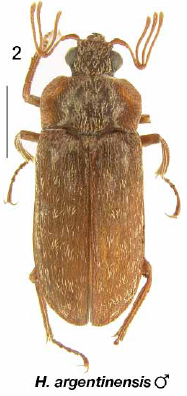| .. |
Scarabaeoidea of Southern South America Links
|
.
|
|
| |
| .. |
Scarab Guide Links
(goes to the University of Nebraska
web site) |
.
Classification |
Superfamily...
Family...........
Subfamily .....
Tribe............
|
Scarabaeoidea
Lucanidae
Aesalinae
Ceratognathini |
|
|
| |
|
| . |
.
Hilophyllus Paulsen and Mondaca, 2006
Hilophyllus Paulsen and Mondaca, 2006: 6. |
| |

|
Hilophyllus argentinensis (Martínez). |
| |
|
Figure 22. Female genitalia of H. penai.
Terminology as in Holloway (1998): BC = bursa copulatrix, H = hemisternite, H9 = ninth
hemisternite, SD = spermathecal duct, SG? = spermathecal gland (not seen), SP = spermatheca, ST
= stylus.
|
| |
|
Figure 25. Localities from which Hilophyllus specimens were examined: H. penai (asterisks), H.
argentinensis (squares), and H. martinezi (triangle). |
| |
|
...... |
Type species: Ceratognathus penai Martínez, 1976: 101. |
| |
...... |
| |
Description.
Length: 8–9.5 mm. Color/Surface: Reddish-brown to dark brown, weakly shining.
Dorsum covered with large punctures (integumental pits sensu Holloway 1998), many
with a single, elongate, apically acute scale arising at center; scales
longitudinally ribbed, lacking anastomosing cross-bars. Ventral surface coarsely punctate,
setose. Head: Frons lacking tubercles. Eyes lacking canthus, enlarged in males.
Mandibles small in both sexes, interlocking when closed, not longer than 1/2 length of
head, tridentate (larger acute apical tooth with dorsal and ventral teeth); apical tooth
strongly curved inward at middle in male, gradually curved in female; dorsal tooth broader
in male; ventral tooth of right mandible generally strong, occasionally reduced to barely
indicated angulation. Antennae 10-segmented, non-geniculate. Scape more than
3x longer than second segment, curved, with dorsal carina dividing the anterior and
posterior faces (less noticeable on female); anterior face of scape alutaceous with several
stout, erect bristles; posterodorsal face glabrous, shining, lacking longitudinal groove.
Club three-segmented, sexually dimorphic (male club segments elongate, slender, as long
as or longer than length of head, female club segments subequal in length to 1/2 length of
head), segments subcylindrical, slightly increasing in diameter distally, densely
pubescent except at base; pubescence long, golden, longer in male than in female.
Pronotum: Sides explanate to strongly explanate, more strongly explanate in males.
Anterior angle produced or truncate, converging strongly to head in female. Lateral margin
broadly rounded, widest at middle. Elytra: Shape elongate, slightly broader in female,
widest at basal third. Legs: Anterior tibiae with apical tooth and one prominent median
tooth (teeth stronger in females), remaining teeth smaller and uniform (more or less
serrate). Mesotibiae with or without external tooth. Metatibiae elongate,
cylindrical in cross-section, lacking larger teeth or spines, with regular, longitudinal rows
of setae. Abdomen: Apex of 5th ventrite truncate in males, convex in females. Male
genitalia: Internal sac eversible. Basal piece large, median lobe bulbous basally and
narrowing to apex, contiguous with parameres, sclerotized dorsally, undivided ventrally. Parameres symmetrical and elongate, lacking longitudinal ribbing, apex simple, bidentate,
or hooked. Paired plates on dorsum of 9th abdominal segment (genital capsule) triangular.
Female genitalia: (Fig. 22, H. penai examined) Hemisternite laterally emarginate,
emargination receiving apex of 9th hemisternite. Bursa copulatrix bilobed. Spermathecal
duct much shorter than spermatheca (spermathecal gland not located on dissected
specimen). |
| ...... |
|
| |
Distribution.
South America: Central Chile and adjacent areas of Argentina. |
| |
|
|
Diagnosis.
Head unarmed, lacking tubercles on frons. Antennal scape with anterior face
alutaceous, posterodorsal face shining, without longitudinal groove. Hind tibiae of male
with regular longitudinal rows of setae, lacking setiferous patch. Male mandibles small,
similar in shape and size to female mandibles, not highly sexually dimorphic. Elytral
scales elongate, apically acute. Female genitalia with short, broad styli. |
| |
|
| |
Excerpt from:
Paulsen, M. J. & J. Mondaca E. 2006. Revision of the South American Ceratognathini (Coleoptera:
Lucanidae: Aesalinae) with the description of a new genus and
a new species. Zootaxa 1191: 1–19. |
| |
|

